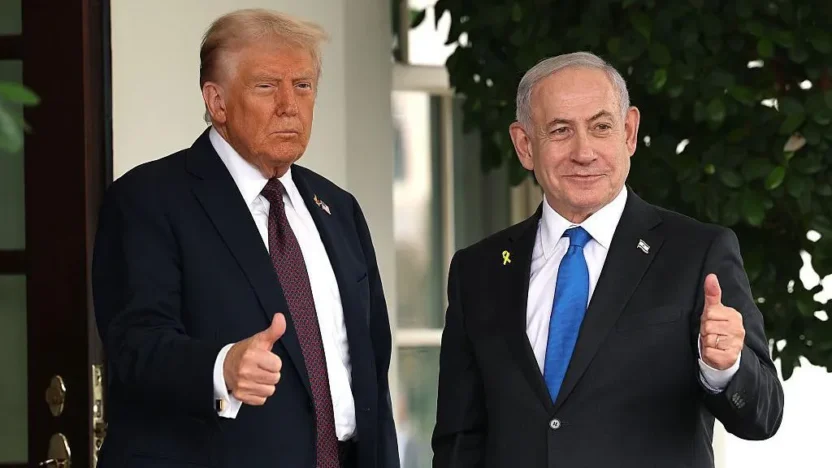A Historic Moment for Gaza Peace: Israel and Hamas Move Toward Historic Ceasefire Agreement
US President Donald Trump announced on September 29, 2025, that Israel and Hamas have agreed to the first phase of a comprehensive 20-point peace framework aimed at ending two years of devastating war in Gaza, securing the release of Israeli hostages, and establishing a pathway to permanent peace in the region.
The announcement was delivered during a White House meeting with Israeli Prime Minister Benjamin Netanyahu, who publicly endorsed the proposal, marking a significant diplomatic breakthrough in one of the world’s most intractable conflicts.
Key developments:
- September 29, 2025: Trump unveils 20-point plan with Netanyahu
- October 3, 2025: Hamas agrees to key provisions including hostage release
- Ongoing negotiations in Egypt to finalize implementation details
Sources: White House Press Office, NPR, CNN, Al Jazeera, PBS News
Israel and Hamas Response: Where Do Both Sides Stand?
Israel’s Position
Prime Minister Netanyahu endorsed Trump’s plan during the September 29 White House meeting, stating that Israel accepts the terms as a framework for ending hostilities. However, Israel has not yet officially accepted the plan through a formal cabinet vote, which is required for full implementation.
Following Hamas’s October 3 response, Netanyahu’s office released a statement saying Israel is preparing to immediately implement the first phase of Trump’s plan for the prompt release of all hostages, emphasizing full cooperation with President Trump.
Trump’s 20 Point Gaza Peace Plan: Hamas’s Conditional Agreement
On October 3, 2025, Hamas announced it would agree to release all 48 remaining Israeli hostages—both living and deceased—in exchange for Palestinian prisoners held in Israeli jails and detainees from Gaza. The group also agreed to relinquish governance of Gaza to Palestinian technocrats, addressing one of the plan’s key demands.
Critical caveat: Hamas did not explicitly agree to the plan’s requirement for complete disarmament, which remains a potential stumbling block in negotiations.
Sources: NPR, NBC News, CNN, CBS News, Washington Post
The Complete 20-Point Gaza Peace Plan
Phase 1: Immediate Ceasefire and Hostage Release
Point 1: Terror-Free Gaza
Gaza will be transformed into a deradicalized, terror-free zone that poses no threat to neighboring countries. This represents the foundational security principle underlying the entire agreement.
Point 2: Reconstruction for Gazans
Gaza will be comprehensively redeveloped for the benefit of its residents, who have endured tremendous suffering throughout the conflict.
Point 3: Immediate War Cessation
If both parties accept the proposal, the war will end immediately. Israeli forces will withdraw to predetermined positions to facilitate hostage releases, with all military operations—including aerial bombardment and artillery strikes—suspended until conditions for complete staged withdrawal are met.
Point 4: 72-Hour Hostage Return
Within 72 hours of Israel’s public acceptance, all hostages—both living and deceased—must be returned. This accelerated timeline reflects the urgency both sides have expressed regarding the hostage crisis.
Point 5: Prisoner Exchange Terms
Following complete hostage release, Israel will release 250 Palestinian prisoners serving life sentences, plus 1,700 Gazans detained after October 7, 2023, including all women and children. For each deceased Israeli hostage returned, Israel will release the remains of 15 deceased Gazans—a provision addressing Palestinian demands for dignified treatment of their dead.
Sources: White House Official Document, PBS News, Al Jazeera
Governance and Political Transition
Point 6: Hamas Amnesty and Exit
Hamas members who commit to peaceful coexistence and weapon decommissioning will receive amnesty. Those wishing to leave Gaza will be granted safe passage to receiving countries willing to accept them—potentially including Qatar, Turkey, or other nations.
Point 7: Immediate Humanitarian Aid
Upon acceptance, full humanitarian aid will immediately flow into Gaza, with quantities matching or exceeding levels specified in the January 19, 2025 agreement. This includes infrastructure rehabilitation (water, electricity, sewage systems), hospital restoration, bakery reconstruction, and equipment for rubble removal and road clearing.
Point 8: Unfettered Aid Distribution
Aid distribution will proceed through the United Nations, Red Crescent, and international institutions with no interference from either party. The Rafah crossing will operate according to mechanisms established in the January 2025 agreement.
Point 9: Technocratic Palestinian Government
Gaza will be governed by a temporary “technocratic, apolitical Palestinian committee” responsible for daily public services and municipal functions. This committee will comprise qualified Palestinians and international experts.
The “Board of Peace”: A new international body called the “Board of Peace” will provide oversight, chaired by President Trump himself, with former British Prime Minister Tony Blair among its members. This board will manage Gaza’s redevelopment until the Palestinian Authority completes comprehensive reforms and can securely assume control.
Sources: White House, CNN, Al Jazeera
Economic Development and Investment
Point 10: Trump Economic Development Plan
A specialized economic development plan will be created by convening experts who have helped build successful modern cities across the Middle East. The plan will synthesize security frameworks with governance structures to attract investment, create jobs, and foster economic opportunity.
Point 11: Special Economic Zone
A special economic zone will be established with preferential tariff rates and market access agreements to be negotiated with participating countries, potentially transforming Gaza into a regional trade hub.
Point 12: Freedom of Movement
No one will be forced to leave Gaza. Residents may voluntarily depart and retain the right to return. The plan explicitly encourages Palestinians to remain and participate in building a prosperous new Gaza.
Sources: White House Official Plan, NBC News
Security and Demilitarization
Point 13: Hamas Exclusion and Complete Demilitarization
Hamas and affiliated factions will have no governance role—direct, indirect, or otherwise. All military infrastructure, including underground tunnels and weapons production facilities, will be destroyed and not rebuilt.
Demilitarization process:
- Independent monitors will supervise weapon decommissioning
- Internationally funded buyback programs will incentivize voluntary weapon surrender
- Reintegration programs will help former combatants transition to civilian life
- All processes will include international verification mechanisms
Point 14: Regional Guarantees
Regional partners will provide guarantees ensuring Hamas and other factions comply with obligations and that reconstructed Gaza poses no threat to neighbors or its own residents.
Point 15: International Stabilisation Force (ISF)
The United States will work with Arab and international partners to deploy a temporary International Stabilisation Force immediately upon implementation.
ISF responsibilities:
- Train and support vetted Palestinian police forces
- Consult with Jordan and Egypt on security best practices
- Secure Gaza’s borders in coordination with Israel and Egypt
- Prevent weapons smuggling while facilitating legitimate commerce
- Serve as the long-term internal security solution
Point 16: Israeli Non-Annexation and Phased Withdrawal
Israel will neither occupy nor annex Gaza. According to proposed maps, Israeli forces would initially remain up to 6.5 kilometers inside southern Gaza, 2 kilometers in central Gaza, and 3.5 kilometers in northern Gaza following hostage release.
As the ISF establishes control, the IDF will progressively withdraw based on agreed standards, milestones, and timeframes linked to verifiable demilitarization. A security perimeter presence will remain until Gaza poses no resurgent terror threat.
Sources: CNN, White House, Washington Post
Long-Term Political Framework
Point 17: Terror-Free Zone Prioritization
If Hamas delays or rejects the proposal, implementation—including scaled-up aid operations—will proceed in terror-free areas transferred from IDF to ISF control, creating incentives for cooperation.
Point 18: Interfaith Dialogue Initiative
An interfaith dialogue process will be established promoting tolerance and peaceful coexistence, attempting to reshape Palestinian and Israeli narratives by emphasizing peace dividends.
Point 19: Pathway to Palestinian Statehood
As Gaza redevelopment advances and when the Palestinian Authority faithfully implements its reform program, conditions may emerge for a credible pathway to Palestinian self-determination and statehood—recognized as the Palestinian people’s aspiration.
However, Netanyahu stated on September 30 that a Palestinian state would not be established under Trump’s plan, creating potential discord over the agreement’s ultimate political objectives.
Point 20: US-Facilitated Political Dialogue
The United States will establish ongoing dialogue between Israel and Palestinians to agree on a political horizon for peaceful, prosperous coexistence.
Sources: White House, Al Jazeera, NBC News, Wikipedia
Current Status: Negotiations Continue in Egypt
Negotiators are currently in Egypt working to finalize implementation details based on Trump’s framework as Israel marks the anniversary of the October 7 Hamas attacks.
Key Outstanding Issues:
- Hamas Disarmament: While Hamas agreed to hostage release and governance transition, explicit acceptance of complete disarmament remains unclear
- Israeli Cabinet Vote: Netanyahu’s government must formally approve the plan through cabinet procedures
- Implementation Timeline: Specific dates and milestones for IDF withdrawal need finalization
- ISF Composition: Which nations will contribute forces to the International Stabilisation Force
- Palestinian Statehood: Fundamental disagreement between plan’s language and Netanyahu’s position
President Trump stated in a Truth Social post that “ALL of the Hostages will be released very soon, and Israel will withdraw their Troops to an agreed upon line as the first steps toward a Strong, Durable, and Everlasting Peace.”
Sources: CNN, Al Jazeera, NBC News, ABC News
International Reaction and Analysis
United Nations Response To Trump’s 20 Point Gaza Peace Plan
The World Health Organization welcomed the peace plan for Gaza, calling for an immediate end to war, hostage releases, humanitarian aid resumption, reconstruction including hospitals, and peaceful prosperity. Also see https://scienceandaerospace.blog/blog/trump-meets-with-russian-president-a-high-stakes-encounter-amid-global-tensions/
Expert Analysis
Atlantic Council assessment: While Hamas’s agreement to release hostages and enter negotiations represents significant progress, the organization called for further consultations on other elements, suggesting the path to final agreement remains complex.
Regional Implications
The plan’s success depends heavily on:
- Arab state willingness to participate in the ISF and Board of Peace
- Palestinian Authority’s ability to implement demanded reforms
- International community’s commitment to reconstruction funding
- Regional powers’ guarantees of Hamas compliance
Sources: Al Jazeera, Atlantic Council, Washington Post
What Happens Next: Critical Steps Forward
Immediate Next Steps (October-November 2025):
- Formal Acceptance: Israeli cabinet vote to officially accept the plan
- Implementation Agreement: Finalization of specific timelines and procedures in Egypt
- Hostage Release: Execution of 72-hour hostage return upon acceptance
- Ceasefire Activation: Immediate cessation of military operations
- Aid Surge: Humanitarian assistance flowing into Gaza
Medium-Term Goals (6-12 Months):
- ISF Deployment: Assembly and deployment of international stabilization forces
- Technocratic Government: Installation of Palestinian governance committee
- IDF Withdrawal Begins: Phased military pullback as ISF assumes control
- Demilitarization Process: Weapon buyback and tunnel destruction programs
- Infrastructure Rebuilding: Water, electricity, medical facility restoration
Long-Term Vision (2-5 Years):
- Complete IDF Withdrawal: Full Israeli military departure from Gaza
- PA Assumption of Control: Reformed Palestinian Authority takes governance
- Economic Development: Special economic zone operational, investment flowing
- Political Horizon Dialogue: Serious negotiations on Palestinian statehood pathway
- Regional Integration: Gaza’s integration into regional economic frameworks
Sources: White House Implementation Timeline, Expert Analysis
Critical Challenges and Potential Obstacles
Political Challenges
Israeli Domestic Politics: Netanyahu faces far-right opposition in his coalition government, raising questions about whether he will fully implement the plan even after endorsing it.
Hamas Hardliners: Not all Hamas factions may accept disarmament and power transfer, potentially creating internal Palestinian conflict.
Palestinian Authority Weakness: The PA’s ability to implement required reforms and govern Gaza effectively remains questionable after years of limited authority.
Security Concerns
Weapons Smuggling: Preventing rearmament while facilitating reconstruction presents enormous logistical challenges.
Extremist Spoilers: Other militant groups in Gaza may reject the agreement and attempt to derail implementation.
Regional Instability: Broader Middle East tensions could impact international support and regional guarantees.
Economic Realities
Reconstruction Costs: Rebuilding Gaza will require tens of billions of dollars in sustained international investment.
Donor Fatigue: Previous reconstruction efforts have seen funding commitments go unfulfilled.
Economic Viability: Creating a sustainable Gaza economy requires market access and trade opportunities that may face political obstacles.
Sources: Al Jazeera Analysis, CNN, Washington Post
Historical Context: Previous Peace Efforts
Trump’s 20-point plan builds on decades of failed peace initiatives:
- Oslo Accords (1993-1995): Established Palestinian Authority but failed to achieve final status agreement
- Camp David Summit (2000): Collapsed without agreement on core issues
- Trump’s First-Term “Deal of the Century” (2020): Rejected by Palestinians as heavily favoring Israel
- January 2025 Agreement: Provided humanitarian framework now incorporated into current plan
What’s different this time:
- Immediate ceasefire tied to concrete security measures
- International oversight through Board of Peace mechanism
- Economic incentives alongside political framework
- Trump’s personal investment and regional pressure
Sources: Historical Peace Process Documentation
Expert Perspectives: Will This Plan Work?
Optimistic View
Supporters argue the plan’s comprehensive approach addresses security, governance, and economic concerns simultaneously. Trump’s personal involvement and ability to pressure both sides could succeed where previous efforts failed.
Skeptical View
Critics note the plan requires Hamas, a designated terrorist organization, to voluntarily disarm, Palestinian Authority to reform dramatically, and Netanyahu to accept eventual statehood pathway he has rejected. These demands may prove unrealistic.
Regional Analyst Perspective
Middle East experts emphasize that success depends less on the plan’s details than on sustained international pressure, regional state cooperation, and whether both Israeli and Palestinian populations truly desire peace after years of conflict.
Sources: Think Tank Analysis, Academic Experts, Policy Journals
Conclusion: A Fragile Opportunity for Peace
Trump’s 20-point Gaza peace plan represents the most comprehensive diplomatic initiative to end the Israel-Gaza war since hostilities erupted on October 7, 2023. With Israel’s endorsement and Hamas’s conditional acceptance, the framework offers a genuine, if fragile opportunity to end two years of devastating conflict.
The plan’s ambition is both its greatest strength and potential weakness. By addressing security, governance, economics, and long-term political horizons simultaneously, it attempts to create a comprehensive peace ecosystem. However, this complexity also multiplies failure points where implementation could stall.
As President Trump considers traveling to the Middle East in coming days, the international community watches to see whether diplomatic momentum can be sustained through the difficult implementation phase. The coming weeks will reveal whether this latest peace effort becomes historic breakthrough or another unfulfilled promise in the region’s troubled history.
What’s certain: Millions of Israelis and Palestinians have suffered immensely during this conflict. For their sake, the international community must make every effort to give peace a genuine chance.




